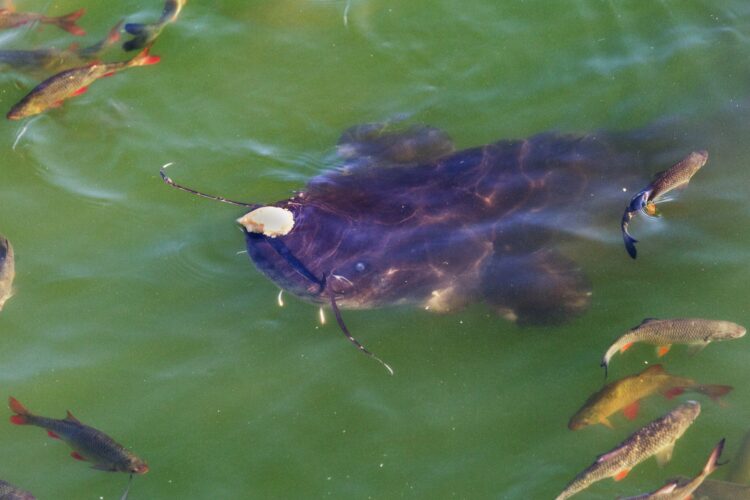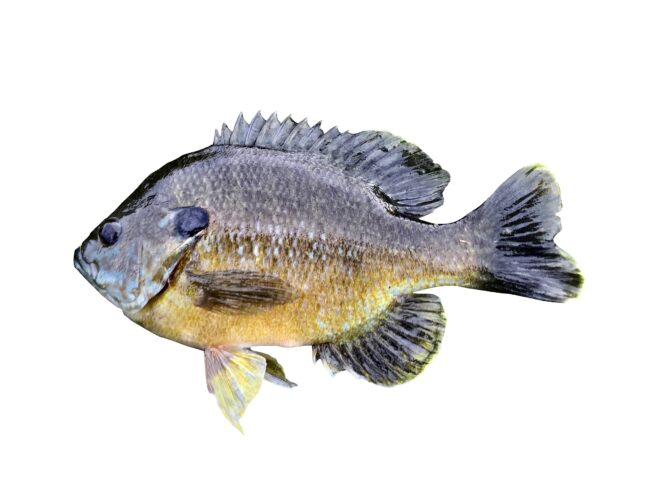Catfish and bluegill are two common freshwater fish species found in many lakes and rivers throughout the United States. While they may look similar to the untrained eye, there are several key differences between the two that set them apart.
One of the main differences between catfish and bluegill is their size. Catfish can grow to be much larger than bluegill, with some species reaching lengths of over six feet and weights of over 100 pounds. Bluegill, on the other hand, are much smaller and typically only reach lengths of around six to ten inches.
Another difference between the two species is their diet. Catfish are primarily bottom feeders and will eat just about anything they can find on the river or lake bed, including other fish, insects, and even small mammals. Bluegill, on the other hand, are omnivores and will eat a variety of different foods, including insects, small fish, and aquatic plants.
Basic Definitions
What Is a Catfish?
Catfish are a type of freshwater fish that are commonly found in rivers, lakes, and ponds throughout North America. They are known for their whisker-like barbels, which are used to detect food and navigate their surroundings. Catfish come in a variety of sizes and colors, ranging from small channel catfish to large flathead catfish. They are bottom feeders and primarily eat insects, small fish, and aquatic plants.
What Is a Bluegill?
Bluegill, also known as bream, are a type of freshwater sunfish that are found in North America. They are known for their blue-green coloration and distinctive black spot on their gills. Bluegill are typically small, reaching a maximum size of around 12 inches. They are often caught for sport fishing and are popular among anglers due to their abundance and willingness to bite on bait. Bluegill primarily feed on insects, small fish, and crustaceans.
Physical Characteristics
Body Shape
Catfish and bluegill have distinct body shapes. Catfish have a long and cylindrical body that tapers at both ends. They have a broad head and a flattened ventral surface. Bluegill, on the other hand, have a compressed and oval-shaped body. They have a small head and a pointed snout. Their dorsal and ventral surfaces are both convex.
Size
Catfish and bluegill also differ in size. Depending on the species, catfish can grow up to several hundred pounds and several feet in length. Bluegill, on the other hand, are much smaller. They typically grow up to 12 inches in length and weigh less than a pound.
Color Patterns
Catfish and bluegill have different color patterns. Catfish are typically dark-colored, ranging from black to brown, and have a mottled appearance. They also have a smooth and slimy skin. Bluegill, on the other hand, have a blue-green or olive-colored back and sides with a yellow or orange belly. They have a spiny dorsal fin and a dark spot on their gill cover.

Habitat Preferences
Catfish Habitats
Catfish are known for their adaptability and can be found in a wide range of habitats. They prefer slow-moving or still waters such as lakes, ponds, and rivers. They are also found in muddy or murky waters and can tolerate low oxygen levels. Catfish are bottom-dwelling fish and prefer to hide in submerged logs, rocks, and other structures. They are most active during the night and prefer to feed in shallow waters.
Bluegill Habitats
Bluegill are freshwater fish that prefer clear, shallow waters with plenty of vegetation. They can be found in lakes, ponds, and slow-moving streams and rivers. Bluegill prefer to stay close to the shore and can often be found near submerged logs, rocks, and other structures. They are most active during the day and prefer to feed in shallow waters. Bluegill are also known to congregate in schools, especially during the spawning season.
Dietary Habits
Catfish Diet
Catfish are opportunistic feeders that consume a wide variety of food items. They are known for their scavenging behavior and will feed on anything they come across. Catfish feed on insects, crustaceans, fish, and even small mammals. They are also known to consume dead animals and plant matter. In captivity, catfish are fed a diet that consists of pellets, worms, and other small aquatic animals.
Bluegill Diet
Bluegill are omnivorous fish that feed on a variety of food items. They primarily feed on insects, crustaceans, and small fish. They are also known to consume plant matter such as algae and aquatic plants. In captivity, bluegill are fed a diet that consists of pellets, worms, and other small aquatic animals.
Behavioral Traits
Feeding Behavior
Catfish and bluegill have different feeding behaviors. Catfish are bottom feeders and are known for scavenging on the bottom of bodies of water. They use their barbels to taste and smell for food. Bluegill, on the other hand, are surface feeders and primarily eat insects and other small aquatic creatures. They have small mouths and use their sharp teeth to crush their prey.
Reproductive Behavior
Catfish and bluegill also have different reproductive behaviors. Catfish are known for their unique breeding habits. During breeding season, the male catfish will create a nest and guard the eggs until they hatch. Bluegill, on the other hand, lay their eggs in a nest created by the male and female. The male then guards the eggs until they hatch.
Fishing Techniques
Catfish Fishing Methods
When it comes to catching catfish, there are a few techniques that can be used. One popular method is using a baited hook and line. This involves attaching a baited hook to a line and casting it into the water, waiting for a catfish to take the bait.
Another technique is using a jug line. This involves tying a line to a floating jug and attaching a baited hook to the end of the line. The jug is then thrown into the water and left to float, with the angler checking it periodically for any bites.
Finally, there is the method of using a trotline. This involves stretching a line across a body of water and attaching multiple baited hooks to the line. The line is then left in the water for a period of time, with the angler checking it periodically for any bites.
Bluegill Fishing Methods
When it comes to catching bluegill, there are also a few techniques that can be used. One popular method is using a small hook and a piece of bait, such as a worm or insect, to attract the fish.
Another technique is using a small jig or spinner. This involves attaching a small lure to the end of the line and casting it into the water, then reeling it in slowly to attract the bluegill.
Finally, there is the method of using a fly. This involves using a small, lightweight fly to mimic the insects that bluegill feed on. The fly is then cast into the water and retrieved slowly, with the angler watching for any bites.

Culinary Uses
Catfish in Cuisine
Catfish is a popular ingredient in Southern cuisine in the United States. It has a mild, sweet flavor and a firm, white flesh that holds up well in cooking. Catfish can be prepared in a variety of ways, including frying, grilling, baking, and smoking. It is often served with tartar sauce or a spicy remoulade sauce.
One popular dish that features catfish is blackened catfish. The fish is coated in a mixture of spices, including paprika, cayenne pepper, and thyme, and then seared in a hot skillet. It is often served with a side of dirty rice or cornbread.
Another popular way to prepare catfish is to fry it. The fish is coated in a seasoned cornmeal mixture and then deep-fried until crispy. It is often served with coleslaw, hush puppies, and a side of hot sauce.
Bluegill in Cuisine
Bluegill is a small freshwater fish that is popular among anglers. It has a mild, sweet flavor and a delicate texture that makes it well-suited for frying. Bluegill is often served as a snack or appetizer, either on its own or as part of a fish fry.
One popular way to prepare bluegill is to bread it in a mixture of cornmeal and flour and then fry it until golden brown. It is often served with a side of tartar sauce or cocktail sauce.
Another popular way to prepare bluegill is to bake it. The fish is coated in a mixture of breadcrumbs and Parmesan cheese and then baked until crispy. It is often served with a side of roasted vegetables or a simple salad.
Conservation Status
Both catfish and bluegill are popular game fish and are often caught for sport or for consumption. However, their conservation status is different.
The International Union for Conservation of Nature (IUCN) considers the bluegill a species of least concern. This means that the bluegill population is stable and not at risk of extinction.
On the other hand, the IUCN considers some catfish species, such as the Mekong giant catfish, critically endangered. Overfishing, habitat destruction, and pollution have led to this status.
It is important to be aware of the conservation status of these fish and to practice responsible fishing techniques to help preserve their populations. This includes following catch limits, using proper equipment, and releasing fish that are not being kept for consumption.
By taking these steps, anglers can help ensure that both catfish and bluegill continue to thrive in their natural habitats for generations to come.











